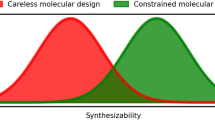Abstract
An evolutionary algorithm was developed for fragment-based de novo design of molecules (TOPAS, TOPology-Assigning System). This stochastic method aims at generating a novel molecular structure mimicking a template structure. A set of ∼25,000 fragment structures serves as the building block supply, which were obtained by a straightforward fragmentation procedure applied to 36,000 known drugs. Eleven reaction schemes were implemented for both fragmentation and building block assembly. This combination of drug-derived building blocks and a restricted set of reaction schemes proved to be a key for the automatic development of novel, synthetically tractable structures. In a cyclic optimization process, molecular architectures were generated from a parent structure by virtual synthesis, and the best structure of a generation was selected as the parent for the subsequent TOPAS cycle. Similarity measures were used to define `fitness', based on 2D-structural similarity or topological pharmacophore distance between the template molecule and the variants. The concept of varying library `diversity' during a design process was consequently implemented by using adaptive variant distributions. The efficiency of the design algorithm was demonstrated for the de novo construction of potential thrombin inhibitors mimicking peptide and non-peptide template structures.
Similar content being viewed by others
References
Böhm, H.-J., J. Comput.-Aided Mol. Design, 12 (1998) 309.
Kubinyi, H., J. Recept. Signal Transduct. Res., 19 (1999) 15.
Willett, P., Trends Biotechnol., 13 (1995) 516.
Schneider, G., Schrödl, W., Wallukat, G., Nissen, E., Rönspeck, G., Müller, J., Wrede, P. and Kunze, R., Proc. Natl. Acad. Sci. USA, 95 (1998) 12179.
Walters, W.P., Stahl, M.T. and Murcko, M.A., Drug Discov. Today, 3 (1998) 160.
Wrede, P., Landt, O., Klages, S., Fatemi, A., Hahn, U. and Schneider, G., Biochemistry, 37 (1998) 3588.
Böhm, H.-J., Banner, D.W. and Weber, L., J. Comput.-Aided Mol. Design, 13 (1999) 51.
Lewell, X.Q., Judd, D.B., Watson, S.P. and Hann, M.M., J. Chem. Inf. Comput. Sci., 38 (1998) 511.
Kaiser, B., Hauptmann, J., Weiss, A. and Markwardt, F., Biomed. Biochim. Acta, 44 (1985) 1201.
Bode, W., Turk, D. and Sturzebecher, J., Eur. J. Biochem., 193 (1990) 175.
Mohler, M.A., Refino, C.J., Chen, S.A., Chen, A.B. and Hotchkiss, A.J., Thromb. Haemost., 56 (1986) 160.
Rechenberg, I., Evolutionsstrategie-Optimierung technischer Systeme nach Prinzipien der biologischen Evolution (extended edition 1994), Frommann-Holzboog, Stuttgart, 1973.
Willett, P., Barnard, J.M. and Downs, G.M., J. Chem. Inf. Comput. Sci., 38 (1998) 983.
Schneider, G. and Wrede, P., Prog. Biophys. Mol. Biol., 70 (1998) 175.
Schneider, G., Neidhart, W., Giller, T. and Schmid, G., Angew. Chem. Int. Ed. Engl., 38 (1999) 2894.
Walters, W.P., Ajay and Murcko, M.A., Curr. Opin. Chem. Biol., 3 (1999) 384.
Schneider, G., Schuchhardt, J. and Wrede, P., Biol. Cybern., 74 (1996) 203.
Grootenhuis, P.D. and Karplus, M., J. Comput.-Aided Mol. Design, 10 (1996) 1.
Wiley, M.R. and Fisher, M.J., Exp. Opin. Ther. Patents, 7 (1997) 1265.
Rarey, M., Wefing, S. and Lengauer, T., J. Comput.-Aided Mol. Design, 10 (1996) 41.
Banner, D.W. and Hadváry, P., Biol. Chem., 266 (1991) 20085.
Gerber, P.R. and Müller, K., J. Comput.-Aided Mol. Design, 9 (1995) 251.
Bohacek, R.S. and McMartin, C., Curr. Opin. Chem. Biol., 1 (1997) 157.
Author information
Authors and Affiliations
Rights and permissions
About this article
Cite this article
Schneider, G., Lee, ML., Stahl, M. et al. De novo design of molecular architectures by evolutionary assembly of drug-derived building blocks. J Comput Aided Mol Des 14, 487–494 (2000). https://doi.org/10.1023/A:1008184403558
Issue Date:
DOI: https://doi.org/10.1023/A:1008184403558




